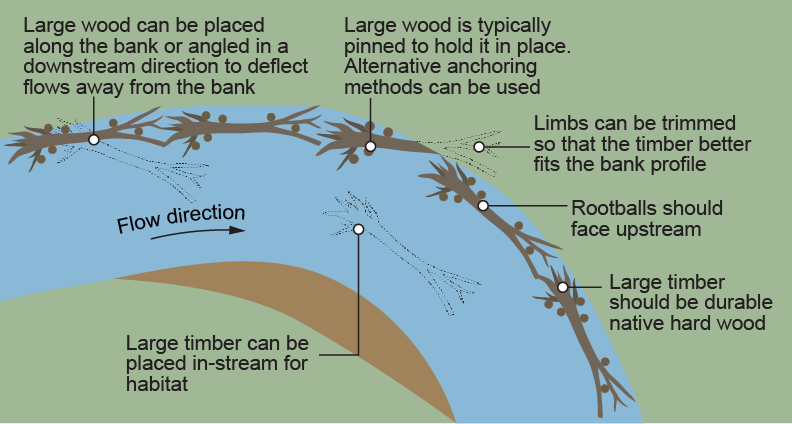|
|
Large wood placementThe placement of large wood (at least 0.1 metre in diameter and 1 metre in length) involves placing large native timber into a river, typically to deflect flow away from the bank. This action can improve habitat, increase hydraulic roughness, and increase geomorphic complexity and diversity at a faster rate than would naturally occur. It is preferential to use native hardwood logs with root balls. The specific arrangement and orientation of placed large wood will be dependent on the project objectives, river type, riverbed load and river energy. Large wood arrangements can vary from single logs to entire trees or engineered timber structures. Depending on the stream power and bed load, stabilisation of the wood may be required to manage the risks involved with the large wood moving and causing damage rather than improving the ecological value. Vertically driven timber piles or ballast blocks can be an effective method of stabilising large wood. Potential benefits from this intervention:
Potential negative implications from this intervention:
Intervention considerations:
Additional informationPublications: Brooks, A. 2006. Design guideline for the reintroduction of wood into Australian streams. Land & Water Australia. Canberra. Price, P. and Lovett, S. 1999. Riparian Land Management Technical Guidelines. LWRRDC. Canberra. Rutherfurd, I.D., Jerie, K. and Marsh, N. 2000. A Rehabilitation Manual for Australian Streams, Volumes 1 and 2. CRC for Catchment Hydrology and LWRRDC. Canberra. Zhang, N. and Rutherfurd, I.D., 2020. The effect of instream logs on river-bank erosion: Field measurements of hydraulics and erosion rates. Earth Surface Processes and Landforms, 45(7), pp.1677-1690. Last updated: 22 June 2022 This page should be cited as: Department of Environment, Science and Innovation, Queensland (2022) Large wood placement, WetlandInfo website, accessed 8 May 2025. Available at: https://wetlandinfo.des.qld.gov.au/wetlands/management/rehabilitation/rehab-process/step-4/intervention-options/large-wood-placement-mod.html |

 — Department of the Environment, Tourism, Science and Innovation
— Department of the Environment, Tourism, Science and Innovation


